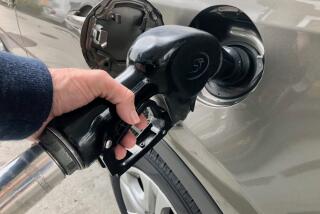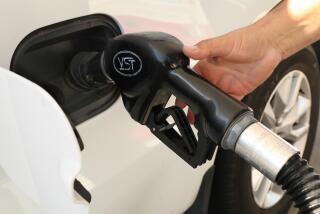Motorists Get Fill of Gas Sites
- Share via
Derrel Green retired 15 years ago from the big seat at the front of an RTD bus, but he still drives a route most days--only now the ride is a glistening silver Toyota Highlander and the stops are a series of gasoline stations near his West Covina home.
Green is on the lookout for pump prices that he can feed to a free Web site that helps consumers find the best deals on gasoline.
Green is a devotee of www .gasbuddy.com, but there are a few other such Web sites and thousands of other such volunteers. These are people willing to burn precious petrol in the monitoring of tens of thousands of gasoline prices nationwide so that fellow motorists can save a few dollars per fill-up.
“To me, it’s a hobby,” said Green, who routinely sees price differences of 20 cents or more per gallon among the retailers he surveys. “I kind of got hooked.”
The Internet would seem to be the perfect forum for this kind of activity. Like a band of traveling coupon-clippers, these gas price “spotters” join together to find the best and worst fuel prices posted each day in communities across the country.
It is a service with noble intentions but with perhaps a limited audience. Because as much as Americans enjoy grousing about the price of gasoline, we are less likely to do something about it, gas experts say.
“I don’t think consumers care as much as they say they do,” said John Umbeck, an economics professor at Purdue University who has studied gasoline marketing. “In today’s society, the price of time is just too important.”
Still, there is no disputing that gasoline prices can swing by a dime or two per gallon in the space of only a few blocks. Such differences are what drive these gasoline price sites and irk the gas spotters, an enthusiastic bunch with a pronounced skepticism about major gasoline producers.
The oldest is the regional gas price survey conducted each week by the Utility Consumers’ Action Network, a San Diego-based consumer advocacy group. The survey is so well followed that retailers have been known to wait until after the survey is posted each Tuesday (at www.ucan.org) before they raise prices.
UCAN uses its pricing survey to push its argument that gasoline is priced unfairly in the San Diego area and that lack of competition keeps prices higher there than in Los Angeles.
The group also hopes to jolt visitors to the gasoline section of its Web site into becoming more savvy shoppers, said Michael Shames, UCAN’s executive director.
Brad Proctor was intrigued by the price disparities he saw among service stations as he delivered a free technology publication to retail outlets in the Midwest two years ago. Proctor was so intrigued that he and a few partners started a Web site called www.gasprice watch.com that he hopes will some day turn a profit by helping consumers shop for gasoline.
“The motivation is to help your friends and neighbors and people you will never meet make a better decision the next time they buy gasoline,” Proctor said.
At www.gasbuddy.com, “there are a lot of people on the Web site who wouldn’t classify themselves as people who are crazy about gas prices. But the thing is, it can really save a lot of money,” said Jason Toews, co-founder of GasBuddy.com, which runs dozens of linked sites posting gas prices for specific areas, including www .losangelesgasprices.com and www .orangecountygasprices.com.
In Arcadia, for example, an Arco station could be found recently on www.losangelesgasprices.com’s list of lowest prices ($1.51 per gallon), while a 76 station nearby made the list of highest prices ($1.69 per gallon). Buying 10 gallons at the cheaper station would save a motorist $1.80.
These sites have lured a loyal cadre of price watchers, attracted by the opportunity at some sites to win points and prizes for inputting prices, or drawn by a community of other motorists who hate to pay too much for gasoline.
At UCAN, the price spotters number less than a dozen, but they are regular volunteers with the consumer group, Shames said. Paid staff members spot check the prices for accuracy.
At www.gasbuddy.com, which is run out of the Minneapolis area, and www.gaspricewatch.com, based in Dayton, Ohio, tens of thousands have registered to post prices.
There’s competition among spotters to find the cheapest or most expensive gas, Toews said.
Spotters get a bit defensive, he said, if a newcomer tries to update a price at a retailer that a regular spotter already has staked out.
“People like to feel that they are making a contribution to the Web site,” Toews said. “They don’t like people to post over their prices.”
The Web sites receive the most visits--and spotters are most active--when gasoline prices are rising. Even so, the Internet is littered with the carcasses of gas sites that are no longer active. One, www.gaswars.com, lists prices entered more than a year ago.
Advertisers were not very interested in supporting the site, figuring “people who are trying to save money on gasoline are cheap to begin with,” said site administrator Darrell Harter, who added that it’s “very hard to keep people coming back.”
Proctor hopes to make his www.gaspricewatch.com site profitable some day through partnerships with gasoline retailers; Toews said his GasBuddy.com covers its costs by selling banner ads.
The appetite for gas-shopping sites has limits, said economist Umbeck.
In one study Umbeck conducted for a major gasoline retailer, which he declined to name, the corporation wanted to know how customers chose among the many outlets selling that particular brand of gasoline. In more than 200 interviews, price was never mentioned as a factor.
In another study, Arco let Umbeck and a colleague change the posted price of gasoline up or down by 2 cents a gallon at 54 company-owned stations in Los Angeles, San Francisco and San Diego for a week at a time. The Purdue professors then recorded how much business the Arco outlets lost or gained.
The change was surprisingly small, he said--even in Los Angeles, where gas stations are more plentiful and motorists have more options than in San Francisco or San Diego.
“It was a real eye-opener for me,” Umbeck said. “I’ve been studying gasoline marketing for 20 years. I would have guessed that consumers were a little more willing to go out of their way to save money on gas.”
Motorists are more interested in convenience, Umbeck said, which could be defined as a gas station that accepts credit cards at the pump or a station on the right side of the road or a station with fast pumps.
Annemarie Curry can’t understand that kind of shopping, even though she doesn’t need to count pennies. Curry, a film producer, and her husband both own luxury cars, but she will drive a few blocks out of her way to find the best price.
On long weekend driving trips, the savings really add up, Curry said. The couple plan their gas stops based on prices posted at www.gaspricewatch.com and can save 20 cents or more per gallon, she said.
“It’s startling how much prices can vary,” Curry said. “As soon as the gas prices spike in summer, it becomes even more critical to know where you can find the cheap ones.”
“It’s human nature,” Curry said. “Everyone loves a bargain.”
More to Read
Inside the business of entertainment
The Wide Shot brings you news, analysis and insights on everything from streaming wars to production — and what it all means for the future.
You may occasionally receive promotional content from the Los Angeles Times.










